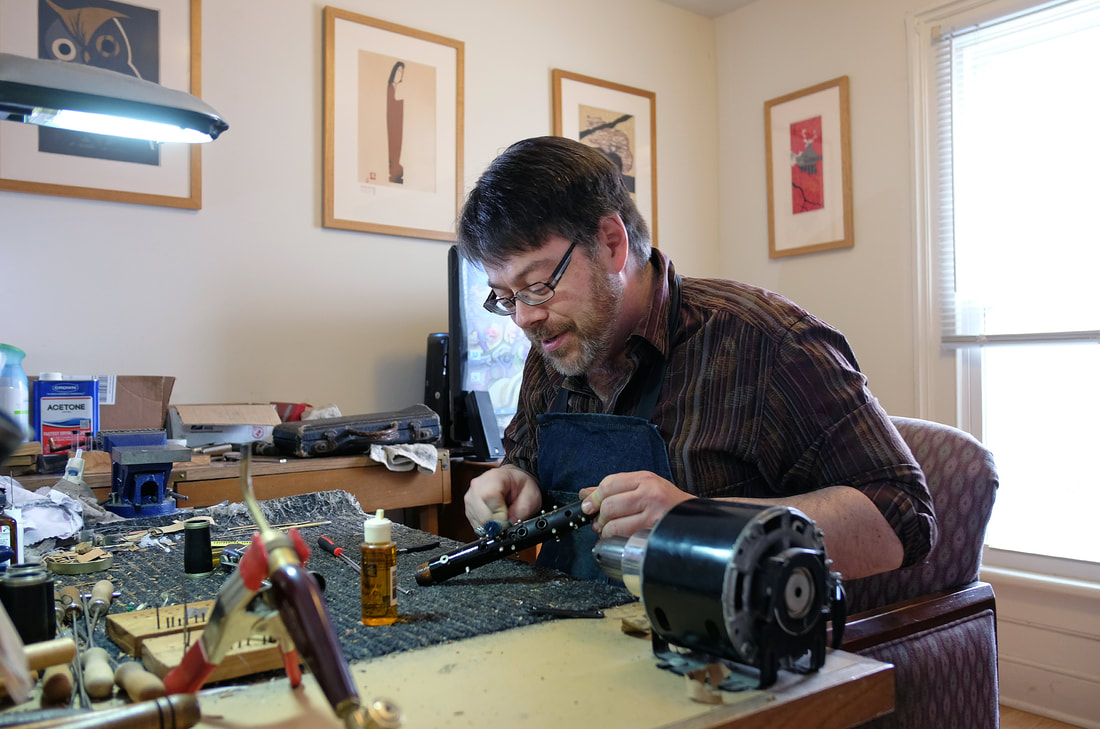|
With the change of seasons, I thought it might be a good time for a vintage clarinet care post - I've been seeing a lot of dried out, neglected clarinets here in the shop!
An older wood clarinet is going to need more care than a new one for best performance, and quite a bit more than that student plastic horn you used to abuse, so let's get to it! 1 - Swab it after you play, but avoid inserts. You want to get the moisture out - not put it back in! Those fuzzy inserts absorb from the body and pads, with regular use, and then it goes...right back in the clarinet! Just swab from both ends and put it away. 2 - Bore oil is your friend. I'm amazed at the number of folks I meet that don't use it and the number of horns I receive that desperately need it! Buy a good quality brand that has some natural oils (not just petroleum distillates) and a fuzzy clarinet bore swab. Put a few drops on the swab and run it through all 4 pieces of the body until you see a light 'sheen' in there: don't soak it! If the horn is really dry, it may be necessary to repeat this a few times in the first week. Eventually, once a month or so will be enough to keep it looking healthy: this will protect it from cracks and warpage and extend the useful life of your instrument! 3 - Humidify. While you don't want a damp insert holding moisture right next to your pads, you do want a little humidity in there, especially during the winter or if you live in an arid part of the country. Take a tip from the old pros and put a couple pieces of orange rind in the bell: it will make the case smell nice and protect the bell in particular from the shrinkage that loosens rings and causes cracks. 4 - Oil the mechanism. A lot of the looseness in old clarinet keys is the result of un-lubricated dirt between the key and the post being rubbed back and forth, thousands of times, until metal gradually wears away. A good way to improve movement and arrest wear is to buy a little bottle of key oil (I like Hetman's) with a needle fitting and hit the contact points at each end of the key with a drop, about twice a year. 5 - Watch that thermal shock! Wooden clarinets don't like dry heat, direct sun, or sudden temperature changes. Don't leave it in a car on a hot day, or march with it, or set it near a heat source. No company guarantees their horns against cracking, and I can't either! Ironically, your old clarinet will probably withstand the rigors of use better than a new one: its wood blanks were aged longer before cutting, and it has had years to stabilize since then. I see many clarinets 80+ years old that look and play great! If you take care of yours, someone might be playing it many years from now, as well....
1 Comment
6/11/2019 11:31:51 pm
If you want a clarinet to march with, get a metal one!
Reply
Your comment will be posted after it is approved.
Leave a Reply. |
Archives
February 2024
AuthorThe Licorice Shtick Blog is the creation of the Vintage Clarinet Doctor, a Winston Salem, NC based woodwind instrument repair shop specializing in vintage and antique clarinets, saxophones, and the occasional flute. Categories |

 RSS Feed
RSS Feed